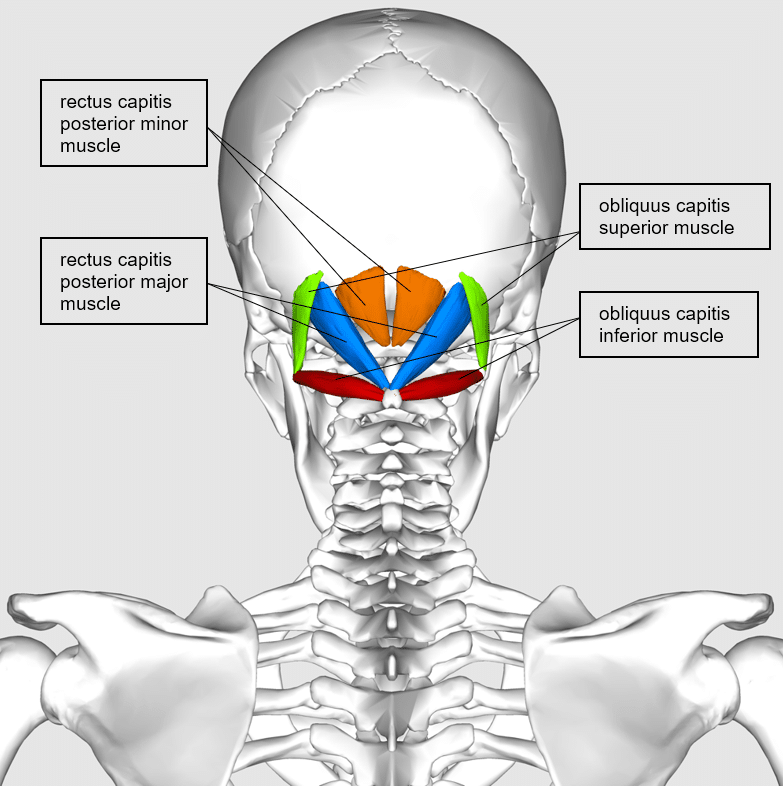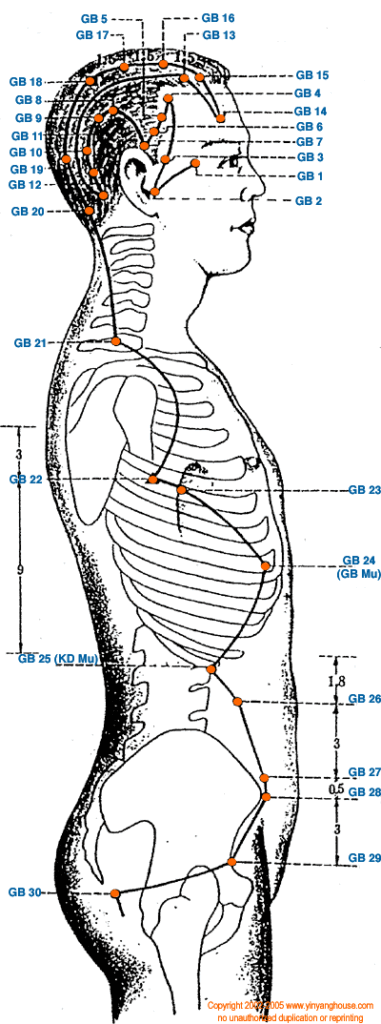As we continue our exploration into holistic migraine treatments, Part 3 of our series delves even deeper into the intricate dance between the gut and the brain. If you’ve ever wondered how the food you eat or the state of your digestive system might influence those debilitating headaches, you’re not alone. Ancient wisdom meets cutting-edge research in this segment, shedding light on the Gut-Brain Axis and its pivotal role in migraine episodes. With special emphasis on acupuncture and the unparalleled benefits of Herbal Formula Gut Harmony (Chorus Capsules), discover how targeting your gut’s health can be a game-changer in your fight against migraines.
A Migraine Treatment Journey
Meet Clara, a vibrant 40-year-old who walked into my clinic with a familiar tale of recurrent migraines. The pain often originated as a tension in her neck, which would progress into migraines.
I found if I push on the rectus capitis posterior major, rectus capitis posterior minor, and obliquus capitis superior, the muscles at the base of her neck, I could cause pain symptoms similar to her HA and Migraines. These muscles lie close to the occipital area of the skull and are instrumental in many head and neck movements.
The pressure exerted by these tight muscles pinched the critical occipital nerves, particularly the greater and lesser occipital nerves. These nerves, originating from the C2 and C3 spinal nerves, innervate parts of our scalp and, when compromised, are often associated with occipital neuralgia. Clara’s description matched occipital neuralgia symptoms: stabbing pain spanning from the suboccipital region to the upper neck, behind the eyes, and the posterior skull area.


Determined to provide Clara with immediate relief, I did acupuncture, utilizing deep needling of gallbladder points GallBladder 20 and 12 and Bladder 9 and 10. The results were swift and encouraging. Clara’s migraines receded from being almost bi-weekly to just once every other week.
While this approach addressed the symptoms and provided short-term relief, I knew from experience that we needed to delve deeper for lasting results. The solution most often is in treating the gut. Despite Clara not showcasing apparent gastrointestinal issues, I started focusing on her stomach health. Drawing connections between the gut and brain, I recognized that while the occiput treatment alleviated the immediate pain, treating the gut was the key to preventing the frequent onset of migraines in the long term.
Gut-Brain Axis and Migraine
The link between the stomach and the head seems obvious to anyone who’s experienced a migraine or seen someone suffer through one. During a migraine episode, it’s not uncommon to feel nauseated, and some people even throw up. While this might seem like a straightforward symptom-response situation, the underlying causes might be deeply rooted in the gut-brain connection.
Understanding the Gut-Brain Axis
The gut-brain axis refers to the two-way communication between our central nervous system (primarily our brain) and our gastrointestinal tract. This communication hinges on the enteric nervous system, a vast network of neurons in the gut, and is mediated by hormones, neurotransmitters, and immune pathways. One notable neurotransmitter is serotonin, often called the “feel good” hormone, which is mainly produced in the gut.
So, What’s the Connection?
Although the exact mechanisms are still a bit of a mystery, a few key takeaways have emerged:
Statistically, migraines seem to be more prevalent in individuals with certain gastrointestinal disorders. Maintaining a diverse and balanced gut microbiome is crucial for optimal brain health. The gut plays a pivotal role in the immune and inflammatory system’s function.
Traditional Chinese Medicine Perspective
In the realm of Traditional Chinese Medicine, the Gallbladder is recognized as a Yang organ. Its inherent nature is hollow, and it thrives on activity and movement. This characteristic resonates with our daily experiences; just as we become frustrated in traffic jams or when halted in our tasks, the Gallbladder reacts adversely to stagnation. It desires a smooth, uninterrupted flow. Partnering closely with the Liver, the Gallbladder plays the role of a drill sergeant to the Liver’s general. While the Liver strategizes and produces bile, the Gallbladder actively carries out the command to excrete it, ensuring the fluid rhythm of Qi (life energy) across the body.
To understand the Gallbladder’s role in migraines, we must examine its channels.
Externally, its channel paints a revealing story. Starting from the eye, it winds its way across the temples, nestles into the occiput base, and descends to the upper trapezius. This trajectory intriguingly mirrors the pathway of the occipital nerves, often implicated in occipital neuralgia and migraine pains.
Internally, the Gallbladder communicates with the stomach and Liver, emphasizing its key function in digestion and Qi circulation.
In the clinic, this understanding translates into a two-phase approach to treating migraines:
1. Immediate Relief: The initial treatment emphasizes alleviating neck tension and stress. This often involves working with the Gallbladder’s external channel, targeting the stressed muscles in the neck region. By harmonizing the flow of Qi in these areas, we can provide quick relief to patients.
2. Sustained Wellness: The next phase delves deeper, focusing on the Gallbladder’s internal channels that influence the stomach. By addressing and nurturing these channels, we aim to reduce systemic inflammation, recalibrate the nervous system, and restore hormonal balance. This holistic approach offers sustained relief from migraines and fosters overall well-being.

Thus, in TCM’s rich tapestry, migraines are not just a localized pain but a manifestation of deeper imbalances. By understanding and respecting the symbiotic relationships of our internal systems, like that of the Gallbladder and the stomach, we can craft a comprehensive, lasting solution to migraines.
Herbal Treatments
While modern approaches like probiotics aim to add or remove specific bacterial strains, Chinese herbal formulas, like Gut Harmony (Chorus Capsules), focus on creating a balanced environment conducive to gut health. Rather than merely planting seeds in an inhospitable environment (akin to probiotics use after taking antibiotics), these formulas work on improving the soil’s quality, ensuring optimum conditions for growth and nourishment.
Understanding Gut Harmony (Chorus Capsules)
A powerful blend that echoes TCM principles, Gut Harmony (Chorus Capsules) merges the best of premium herbs to address stomach health. Its composition is reminiscent of renowned formulas like Bao He Wan. By uniting ingredients like Fu Ling, Huo Xiang, Shan Zha, and more, Gut Harmony creates a formula that:
– Clears phlegm and dampness
– Relieves food stagnation
– Counters the effects of the typical Western diet
– Contains herbs that combat inflammation and repair the digestive system
Given the connection between the stomach and migraines, Gut Harmony (Chorus Capsules) holds significant promise. Research has underscored that interventions like probiotics can inadvertently delay the recovery of the gut mucosa post-antibiotic treatment. This revelation suggests that there’s a pressing need to develop solutions that protect the mucosa without hindering microbiome recolonization.
Its power isn’t merely in replenishing the gut but in fostering conditions that promote healthy bacterial growth. For instance, the herb Mu Xiang (Auklandiae Lappae) is a marvel in this formula. Known for its capacity to regulate Qi and alleviate digestive pain, Mu Xiang has a history of being used for conditions stemming from Qi stagnation or deficiency in the digestive tract. Its significance extends to increasing bile secretion, essential for fat emulsification and the expulsion of waste products like hemoglobin and excess cholesterol.
In essence, Gut Harmony isn’t just another herbal supplement; it’s a carefully crafted symphony of herbs that promises to re-balance our internal systems. It could be the bridge between incessant pain and relief for migraine sufferers, making it an invaluable tool in holistic health arsenals.
Understanding the profound interplay between our gut and brain offers transformative insights into holistic migraine management. Clara’s journey highlights the potential of a comprehensive approach, seamlessly integrating acupuncture with the timeless wisdom of Traditional Chinese Medicine. At the forefront of these solutions, the Herbal Formula Gut Harmony (Chorus Capsules) emerges as a potent tool designed to nurture and balance our gut environment. For those seeking relief from the clutches of migraines, it’s time to consider the potential benefits of the Gut Harmony Formula. Order yours today and embark on a journey towards improved well-being and lasting relief.
Unlock Nature’s Harmony for Your Gut: Feel, Digest, and Live Better with Chorus.
We make available natural products that have been observed to make a difference in the lives of our patients, friends and family. You’re in good hands shopping with us.
About the Author
Willard Sheppy is a writer and healthcare practitioner who seamlessly melds scientific knowledge with practical applications in engaging and authoritative articles. He holds a Bachelor of Science in Environmental Science from Oregon State University and a Master’s in Acupuncture and Oriental Medicine from the distinguished Oregon College of Oriental Medicine.
In his work, Willard skillfully combines his extensive educational background in scientific research with his practical experience as a healthcare practitioner. Willard balances his life with martial arts and cherished family adventures. As a father of three, he often leads his family on camping and hiking trips along the breathtaking Oregon coast.
Connect with Willard on LinkedIn at linkedin.com/in/valleyhealthclinic or learn more about his services at valleyhealthclinic.com. Embark on this journey towards holistic health with Willard!











